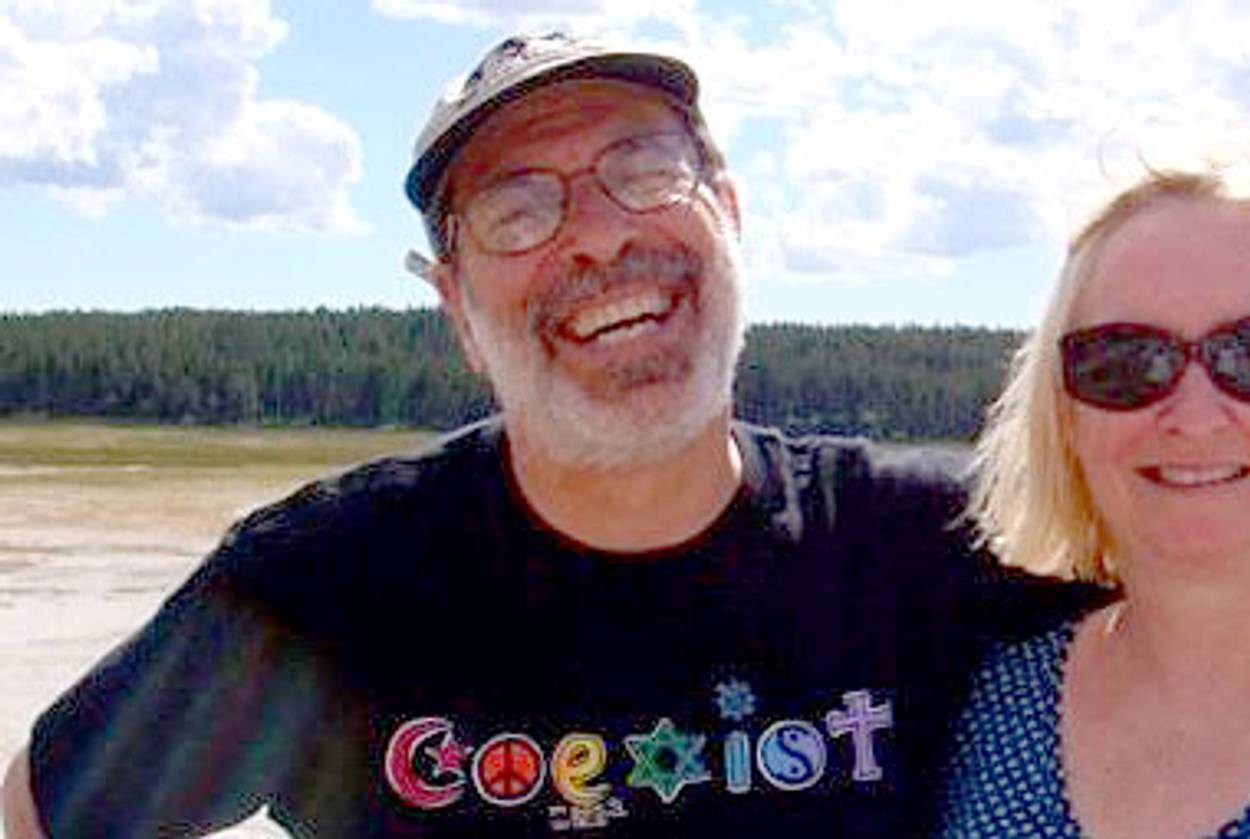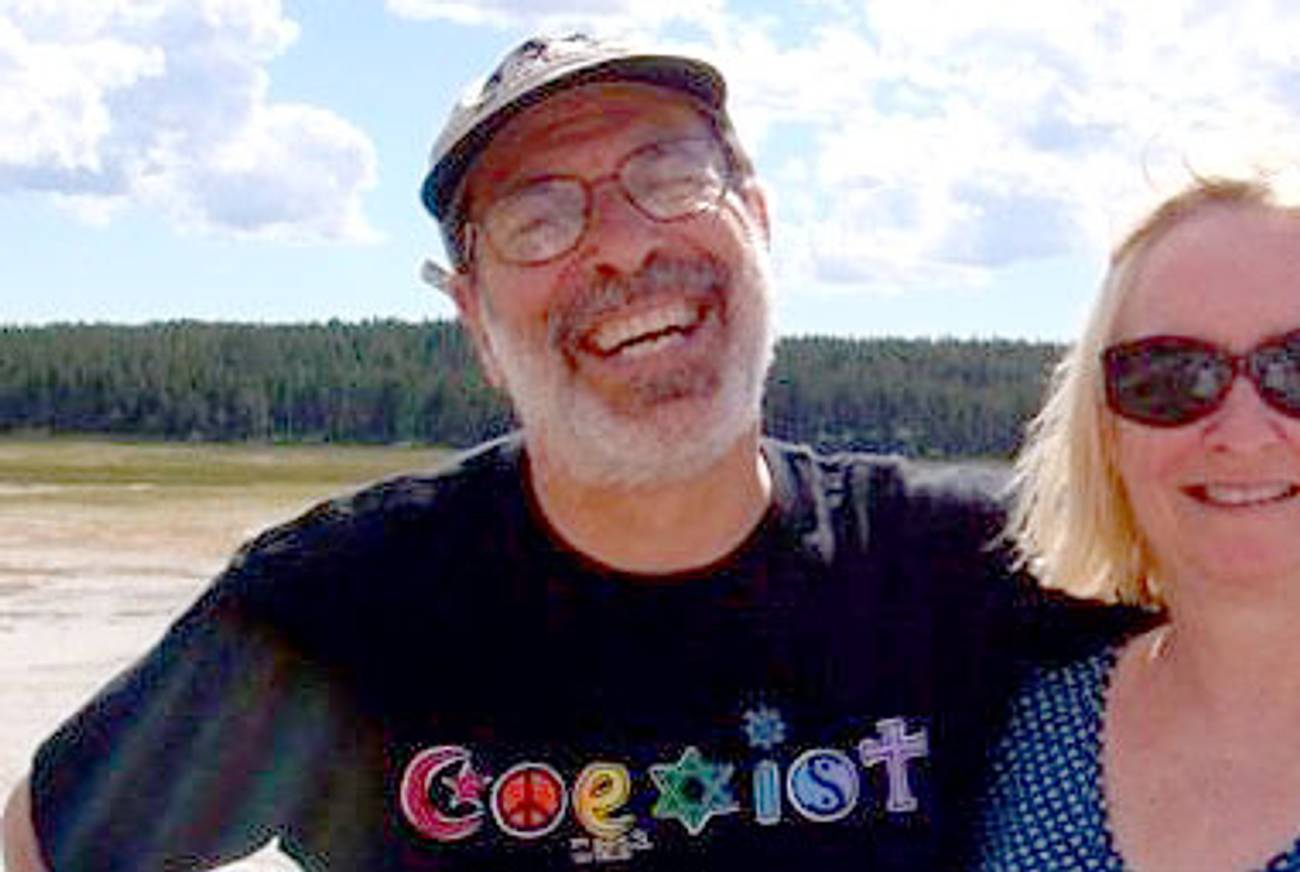Big Tent Country
A Bozeman, Montana, congregation found its rabbi: a former lawyer with a non-Jewish wife




Last week, Ed Stafman—former attorney, former Floridian, former atheist, current rabbi—drove a 26-foot moving truck to Montana to start his new life. On Monday, he and his wife slept in a motel near Mount Rushmore. By Wednesday morning, they were passing through a Crow Indian reservation in the Badlands.
“It feels like we’re on top of the world,” he said.
Stafman’s destination is the city of Bozeman, where, on August 14, he will be installed as the spiritual leader of Congregation Beth Shalom, the Reform synagogue where he has spent 10 days a month for the past year. The ceremony will officially make him one of two active rabbis in the state; the other is an emissary from the ultra-Orthodox movement Chabad, who established a Chabad House in Bozeman in 2004; a third, Beth Shalom’s rabbi emeritus Allan Secher, is retired. It will also make him one of the few intermarried rabbis in the country. Montana is not known as a center of cutting-edge Jewish communal life, and yet by hiring an intermarried rabbi, Beth Shalom has, apparently without dissension, done something that in most synagogues would be as taboo as passing out pork dumplings on Yom Kippur. “I don’t think there’s a single soul in that congregation that resents him being involved in an interfaith marriage,” Secher said. “If there is I absolutely haven’t heard it, and I would have because we’re still very connected.”
That may well be because Montana’s Jewish community is so isolated. Bozeman is a university town of about 35,000 people in a state with about 1,000 self-identifying Jews. Along with Missoula, it’s considered one of Montana’s progressive hubs; Beth Shalom’s president, Jake Werner, compared it to Boulder, Colorado. Almost the entire Jewish community is made up of transplants from around the country. Beth Shalom members say that their congregation is a big tent full of people with often-conflicting views who have nevertheless all sought out the one non-Orthodox shul in town. “You know the joke about three Jews on an island?” asked synagogue board member Franke Wilmer. “There’s only one synagogue on this island.”
“It’s kind of a pioneer congregation,” said Beth Shalom member Bridget Kevane, a Montana State University professor who wrote about Bozeman’s Jews last year for the Forward. “You work with the people who are there to shape a community and it may not be the traditional east coast community.” Kevane’s mother is Jewish, but she was raised Catholic in Puerto Rico; she reconnected with her Jewish roots after marrying a Jewish man. The temple’s past and present presidents are married to non-Jews, as are several other board members. This makeup suggests that what’s really unusual about Bozeman’s Jews is not that they’re heavily intermarried, but that they are intermarried even at the most active, synagogue-going levels.
If Jews in interfaith marriages feel shut out by synagogue life in many places, in Bozeman—where, according to the town’s Chabad rabbi, Chaim Bruk, even 60 percent of Chabad-goers are in intermarried—they’re the only show in town. “I have no doubt that in more established Jewish places it would be more controversial,” Stafman said of his being hired. “There are more expectations, I think. It’s not only a matter of being politically liberal, but a certain kind of open-mindedness and willingness of being able to explore new places, that’s maybe less present in the more established places.”
In many ways, Stafman is a classic second-career rabbi: a socially-minded professional who in middle age felt called to serve on a spiritual plane as well. He grew up in New York and moved to Tallahassee, Florida, for law school. There, he met Beth Lee, the daughter of a Presbyterian minister and a Christian spiritual director who, like Stafman, did not consider herself particularly religious. The two married. He became a criminal defense attorney and, for 25 years, specialized in death penalty cases. He and Lee, a freelance artist and calligrapher, decided to raise their children Jewish, and, when their firstborn reached Hebrew-school age, they joined a Reform synagogue. Stafman eventually became active there, eventually serving as president of the board. Lee said she never had any desire to convert—“I have really wonderful Presbyterian roots,” she noted—but she liked being part of a congregation again.
In 2000, Stafman fought what history may remember as his most important case, though it was far outside his usual purview: he was lead attorney for the Democrats’ case in Ronald Taylor v. Martin County Canvassing Board, one of several disputes over vote counting in the 2000 presidential election that were heard in Florida’s Supreme Court. Unlike Gore v. Bush, Stafman’s case never made it to the U.S. Supreme Court, but as in that case, the results marked a loss for the Democrats. That same year (coincidentally, Stafman said), a friend persuaded him to come to a Jewish Renewal retreat, where he began a turn toward the spiritual that would lead him to the rabbinate. Jewish Renewal, a movement that emphasizes an eclectic mix of mystical and spiritual teachings , “spoke to my soul at a deep level,” Stafman said. He began taking classes at the Renewal-affiliated seminary, the Aleph Rabbinic Program—the only one in the United States that, according to a recent article in the Jewish student magazine New Voices, does not reject intermarried applicants outright. But, said Aleph Rabbinic Program chair Steve Silvern, “we say to them that it’s unusual for a community to hire a rabbi who is in an interfaith marriage,” and counsel them about the strain that one partner becoming a rabbi can place on a relationship.
In 2003, after getting Lee’s blessing, Stafman applied. He continued to practice law for another two years, but then quit working as a lawyer entirely. “Even though I never had a client get the death penalty, there came a time when I came to see that the system lacked any capacity for healing and reconciliation and forgiveness, and I realized I didn’t want to be part of that system anymore,” he said.
Last summer, several months before he was ordained, Stafman inquired about rabbinical positions at two congregations, one in Fort Collins, Colorado, and one in Bozeman. “I made a point on the very first contact of finding out whether they would consider someone who was intermarried,” he said of his initial interviews with Beth Shalom. “And the reaction I got was one of, like, ‘So what?’ And one person said that it might be a great asset because we’re so intermarried here that you might have a better understanding of the congregation. It’s not like there was a universal round of applause that I was intermarried, but I’ve never heard that it was a defect or cause for concern.”
Indeed, said Wilmer, a member of the hiring committee—and a high-ranking Democrat in Montana’s state legislature, who grew up Episcopalian and converted to Judaism after she married a Jewish man from whom she is now divorced—an enthusiasm for working with interfaith families was one of the explicit criteria for candidates. “It’s very much in keeping with our congregation,” said Romi Neustadt, a public relations consultant who volunteers as the temple’s communications director, and is one of Montana’s few native-born Jews. “My husband and I are very much in the minority in that we’re both Jewish. I think it will be very beneficial to those interfaith families in the community, and that they will really feel they have a home at Beth Shalom.”
Of course, there were also practical considerations for the search committee: not too many rabbis, especially those coming out of major rabbinical schools, are eager to take a half-time job in Montana. “We can’t really be choosy about what we we’re getting, we’re not going to have a huge pool,” said Josh Burnim, Beth Shalom’s recently installed president. “We were pretty over the moon to get someone with the qualifications of Ed Stafman.”
The fact that he’s taken an unlikely job isn’t lost on Stafman. “Not too many 55-year-old people leave the home they were in for 30 years, pack up everything they own and put it in two moving vans for a new job that’s actually a half-time position, leaving all of their connections, including friends I’ve had for decades,” he said in a phone conversation as he drove through the Badlands. He trailed off: “I’m looking at my wife and she’s getting upset.”
Marissa Brostoff, a doctoral student in English at the CUNY Graduate Center, is a former staff writer at Tablet and the Forward.
Ari M. Brostoff is Culture Editor at Jewish Currents.